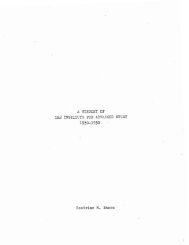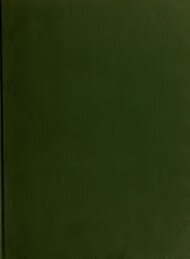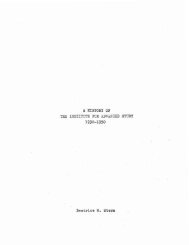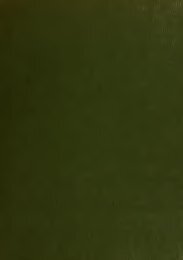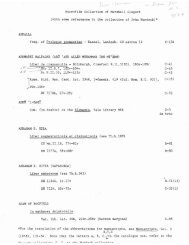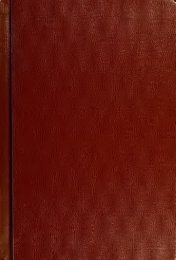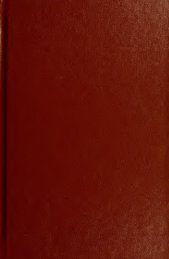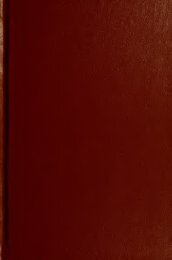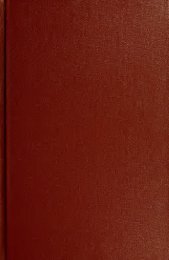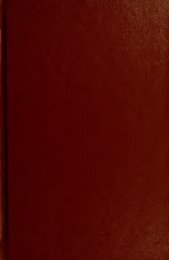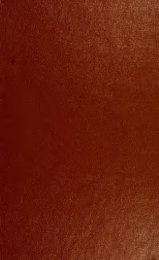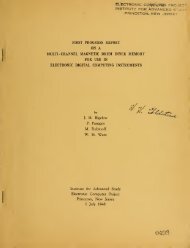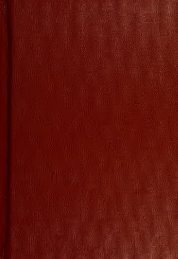Report for the academic year - Libraries - Institute for Advanced Study
Report for the academic year - Libraries - Institute for Advanced Study
Report for the academic year - Libraries - Institute for Advanced Study
You also want an ePaper? Increase the reach of your titles
YUMPU automatically turns print PDFs into web optimized ePapers that Google loves.
The <strong>Institute</strong> tor <strong>Advanced</strong> Stud) was founded in 1930 with a major gift from New<br />
|ersey businessman and philanthropist Louis Bamberger and his sister, Mrs. Felix<br />
Fuld, who wished to use <strong>the</strong>ir <strong>for</strong>tunes to make a significant and lasting contribution<br />
to society. They sought <strong>the</strong> advice of educator Abraham Flexner, who developed <strong>the</strong><br />
concept ot <strong>the</strong> <strong>Institute</strong> as a community of scholars whose primary purpose would he<br />
<strong>the</strong> pursuit ot advanced learning and scholarly exploration. The <strong>Institute</strong> tor<br />
<strong>Advanced</strong> <strong>Study</strong> has sustained its founding principle <strong>for</strong> seventy <strong>year</strong>s. This commitment<br />
his yielded an unsurpassed record ot definitive scholarship.<br />
The <strong>Institute</strong> tills a unique role in postgraduate education and scientific and schol-<br />
arly research. As "<strong>the</strong> university to universities," in <strong>the</strong> words of Trustee Vartan<br />
Gregorian, <strong>the</strong> <strong>Institute</strong> serves all colleges and universities by providing a place<br />
where scholars can hone <strong>the</strong>ir skills and do <strong>the</strong>ir hest work, <strong>the</strong>reby adding substan-<br />
tially to <strong>the</strong>ir ability to contribute as both teachers and scholars to <strong>the</strong> <strong>academic</strong><br />
institutions where <strong>the</strong>y hase <strong>the</strong>ir careers. For young scholars just entering <strong>the</strong> aca-<br />
demic world, an opportunity to work at <strong>the</strong> <strong>Institute</strong> can set <strong>the</strong> direction <strong>for</strong> life-<br />
long research interests and <strong>the</strong>reby determine professional careers. The <strong>Institute</strong><br />
provides more mature scholars with <strong>the</strong> opportunity to take a new direction in <strong>the</strong>ir<br />
research or to complete a major piece of work away from <strong>the</strong> many obligations and<br />
distractions ot working life at a contemporary university. In our era, a time when<br />
pure research and scholarly activities are undervalued, <strong>the</strong>se opportunities are<br />
ex( eedingly rare.<br />
The <strong>Institute</strong>'s <strong>for</strong>emost objective is <strong>the</strong> advancement ot knowledge and <strong>the</strong> deepen-<br />
ing ot understanding across a broad range of <strong>the</strong> humanities, sciences, and social sci-<br />
ences. Oik o! <strong>the</strong> <strong>Institute</strong>'s unique strengths is its small and distinguished perma-<br />
nent Faculty, well-established scholars whose broad interests and extensive ties to <strong>the</strong><br />
larger <strong>academic</strong> world are reflected in <strong>the</strong>ir own work and also in <strong>the</strong> guidance and<br />
direction <strong>the</strong>y provide to <strong>the</strong> <strong>Institute</strong>'s visiting Members. The Faculty defines <strong>the</strong><br />
major <strong>the</strong>mes and question- which become <strong>the</strong> focus of each School's seminar- and<br />
o<strong>the</strong>r activities, and <strong>the</strong> Faculty selects and works closely with visiting Members.<br />
Small in number and organized in tour Schools (Historical Studies, Ma<strong>the</strong>matics.<br />
Natural Niciucs, and Social Science), <strong>the</strong> Faculty and Members can interact with<br />
o<strong>the</strong>r without <strong>the</strong> departmental and disciplinary barriers found in universities.<br />
ii I he <strong>Institute</strong> awards fellowship- to L 80 visiting Members In 'in universities<br />
and research institutions throughout <strong>the</strong> world. The <strong>Institute</strong>'s nearly 5,000 <strong>for</strong>mer<br />
Members hold positions oi intellectual and scu'ii titic leadership in <strong>the</strong> United States<br />
and abroad. More- than a dozen Nobel laureates have been <strong>Institute</strong> b.ic ull\ or Mem<br />
hers, and many more are winners of <strong>the</strong> W'olt or Mae Arthur prizes. Twenty nine out<br />
ot <strong>for</strong>ty two Fields Medalists, <strong>the</strong> Nobel equivalent tor ma<strong>the</strong>maticians, have been<br />
<strong>Institute</strong>- b.u uli\ and Members.<br />
1 1,, <strong>Institute</strong> does not uuiu- income from tuition ot tees. Resources tor operations<br />
com< from endowment income, gram- from private foundations and government<br />
agencies, and gilts from corporations and individuals.



